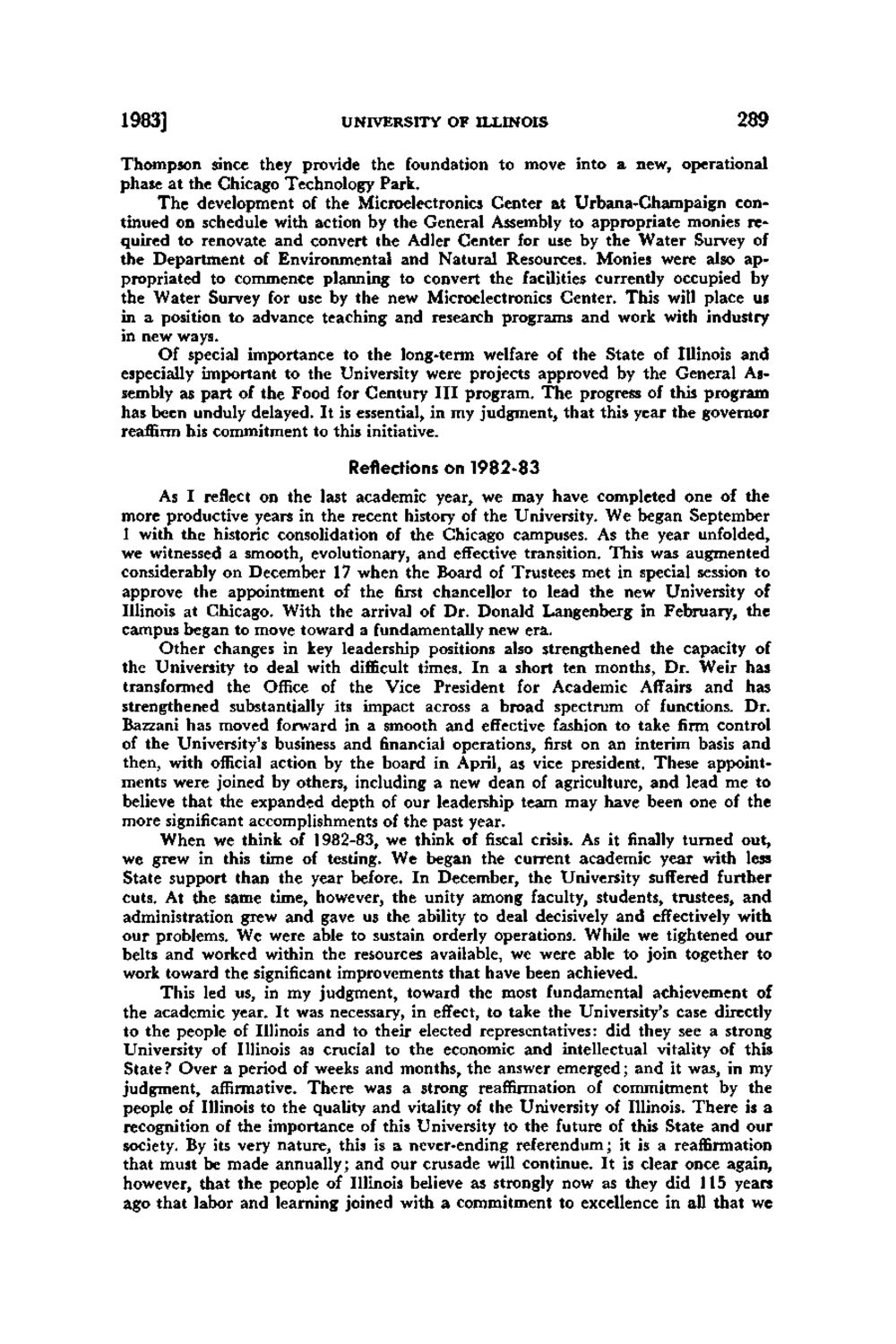| |
| |
Caption: Board of Trustees Minutes - 1984
This is a reduced-resolution page image for fast online browsing.

EXTRACTED TEXT FROM PAGE:
1983] UNIVERSITY OF ILLINOIS 289 Thompson since they provide the foundation to move into a new, operational phase at the Chicago Technology Park. T h e development of the Microelectronics Center at Urbana-Champaign continued on schedule with action by the General Assembly to appropriate monies required to renovate and convert the Adler Center for use by the Water Survey of the Department of Environmental and Natural Resources. Monies were also appropriated to commence planning to convert the facilities currently occupied by the Water Survey for use by the new Microelectronics Center. This will place us in a position to advance teaching and research programs and work with industry in new ways. Of special importance to the long-term welfare of the State of Illinois and especially important to the University were projects approved by the General Assembly as part of the Food for Century I I I program. T h e progress of this program has been unduly delayed. It is essential, in my judgment, that this year the governor reaffirm his commitment to this initiative. Reflections on 1982-83 As I reflect on the last academic year, we may have completed one of the more productive years in the recent history of the University. We began September 1 with the historic consolidation of the Chicago campuses. As the year unfolded, we witnessed a smooth, evolutionary, and effective transition. This was augmented considerably on December 17 when the Board of Trustees met in special session to approve the appointment of the first chancellor to lead the new University of Illinois at Chicago. With the arrival of Dr. Donald Langenberg in February, the campus began to move toward a fundamentally new era. Other changes in key leadership positions also strengthened the capacity of the University to deal with difficult times. In a short ten months, Dr. Weir has transformed the Office of the Vice President for Academic Affairs and has strengthened substantially its impact across a broad spectrum of functions. Dr. Bazzani has moved forward in a smooth and effective fashion to take firm control of the University's business and financial operations, first on an interim basis and then, with official action by the board in April, as vice president. These appointments were joined by others, including a new dean of agriculture, and lead me to believe that the expanded depth of our leadership team may have been one of the more significant accomplishments of the past year. When we think of 1982-83, we think of fiscal crisis. As it finally turned out, we grew in this time of testing. We began the current academic year with less State support than the year before. In December, the University suffered further cuts. At the same time, however, the unity among faculty, students, trustees, and administration grew and gave us the ability to deal decisively and effectively with our problems. We were able to sustain orderly operations. While we tightened our belts and worked within the resources available, we were able to join together to work toward the significant improvements that have been achieved. This led us, in my judgment, toward the most fundamental achievement of the academic year. It was necessary, in effect, to take the University's case directly to the people of Illinois and to their elected representatives: did they see a strong University of Illinois as crucial to the economic and intellectual vitality of this State? Over a period of weeks and months, the answer emerged; and it was, in my judgment, affirmative. There was a strong reaffirmation of commitment by the people of Illinois to the quality and vitality of the University of Illinois. There is a recognition of the importance of this University to the future of this State and our society. By its very nature, this is a never-ending referendum; it is a reaffirmation that must be made annually; and our crusade will continue. It is clear once again, however, that the people of Illinois believe as strongly now as they did 115 years ago that labor and learning joined with a commitment to excellence in all that we
| |